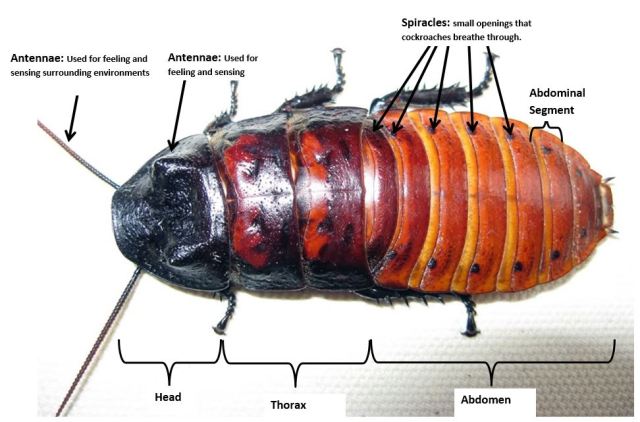I love my cockroaches. They are an incredible medium for teaching SO many fields and topics within science. In addition, they are easy to care for, don’t bite, are not messy, and they are ADORABLE AND AWESOME! (Did you know cockroaches can live without their head for up to 2 weeks!) Below are a few examples of how to utilize your roaches to max teaching potential:
- The obvious one: Teaching about Arthropods.
They have an obvious head, thorax, abdomen, 6 legs, 2 antennae and compound eyes. It is also really easy to see their spiracles that allow them to breathe and hiss. Cockroaches have an open circulatory system which means air flows freely through their body. The spiracles allow for air to be passed in and out of the body through diffusion. For more detail on the topic look here. Open your mouth and quickly breathe out all your air, that is how hissing cockroaches hiss.
2: Talk About Sex and Life Cycles.
The best way to introduce kids to sex is to start with other species and work your way up. Talking about plant ovaries, pistons, eggs and pollen is FASCINATING and doesn’t gross kids out. Then step it up to insect sex. Hissing cockroaches are awesome because they have a hybrid type of egg/live birth. Female cockroaches keep the fertilized eggs in their ovaries and then give live birth! Super cool to watch a female cockroach give live birth. One of my females died while giving birth (to dead babies) and the other roaches ate her and her babies! Talk about a cool lesson on the food chain.

How to sex your roaches: Males and females look different. The males have prominent protrusions, pronotal humps, on the thorax. Females have a smoother thorax with very small bumps or none. Males often have brushier antennae.
3: Teach advanced (or not as advanced) neuroscience by attaching a roboroach tiny backpack to your cockroach and controlling it wirelessing via your cell phone!
Introducing the RoboRoach. Details can be found in the website and their successful kickstarter campaign, but basically you put the backpack on the roach and splice their antenna to insert silver electrodes. You can then send electrical pulses to the cockroaches brain (ganglia) to control its movements. You can then remove the electrodes and allow the cockroach to live out its happy life eating your leftovers.

4: Learn about the scientific method and that all science begins with a question:
This is one of my favorite things to do with kids of all ages.
Challenge the students to be scientists and come up with at least 6 questions about the cockroach(es). Write down each of the questions on a white board or poster board. Label each question by how it can be answered: observation O, experimentation E, and research
Challenge the students to be scientists and try to answer their own question using the methods you mentioned: observation (looking): experimentation (maybe turn into research), or research (computer)
Observation: Questions such as: “What do they eat?” “Can they stick to walls?” And “Are they insects?” can all be answered with observation.
Experiments: I’ve had some great questions from: “do all roaches have germs?” or “does it like dark places”, “do they like pop music?” “what is their favorite color.” You can help them strategize an experiment. If you have time do the entire experiment and build on it. This is great for understanding variables and controls using the concept of fairness. For example “If I want to see which food a cockroach prefers, is it fair to give every cockroach different amounts of food or should they all have the same amount?”
Research: If you cannot answer a question through observation or experimentation, try research. Mr. Google knows a lot of shit. Encourage students to look their question up online or contact people such as teachers, professors, or naturalists.
5: Children LOVE them.
Even if kids are unsure while they are out, they will be talking about their roach experience for years. 
6: They are COOL! Here are some awesome facts about roaches I have found. These could be awesome for experiments (liking eating them to solve health issues!)
There are about 5,000 species of roaches
No food for a month–not even a crumb? Roaches can go without eating for a month but will only live a week without water. A cockroach can live a week without its head. It only dies because without a mouth, it can’t drink water.
Cockroaches have at least 18 knees.
Cockroaches are some of the most ancient insects. Fossil records show their relatives have been around, virtually unchanged in appearance, for over 350 million years.
Roaches wear their skeletons on the outside of their bodies.What if you skinned your knee and white blood came out? If you’re a cockroach, no big deal. Cockroachesbleed white blood.
Cockroaches have six hairy legs. The tiny hairs found on each leg give them their sense of touch.
Roaches recognize family and friends by their distinctive odors.
Don’t complain next time you have to swallow cough syrup. You could be taking a dose of cockroaches instead!
Processed cockroaches have been used to cure illnesses and physical disorders for centuries.
Next time you have trouble going pee, and your urinary tract just doesn’t want to go with the flow, why not try dried and powdered Oriental cockroaches? They are said to make a dandy diuretic.
A vampire’s dream: blood that sloshes around freely in a body. Roaches’ blood does just that. They have no blood vessels to speak of.
A cockroach heart is nothing but a simple tube with valves. The tube can pump blood backwards and forwards in the insect. The heart can even stop moving without harming the roach.
Notice how thin these roaches are. Roaches can fit through cracks that are as thin as a dime.
Cockroaches have no lungs
Cockroaches are nocturnal and will run away when exposed to light. The only exception is the Asian Cockroach which is attracted to light.
It is true that cockroaches have a higher radiation resistance than humans (5-11 times greater), but they are not exceptionally radiation resistant compared to others such as the fruit fly. They have extra radiation hardiness because cells are most vulnerable to effects of radiation while dividing and cockroach cells divide only once each time they molt.
Cockroach legs are now being used as an inspiration for robotic legs.
Cockroaches are great at making group decisions and have a good balance between cooperation and competition. An experiment with 50 roaches and three shelters that had a 40 roach capacity showed that roaches divided themselves 25/25 into two shelters. When the shelter capacity was greater, all roaches moved into the shelter.
Okay not convinced yet? Buy a few and give it a try. Whats’ the worst that can happen? They are cheap and Peter(?) has tons of them for sale. www.bugsincyberspace.com. They come in a little tuperware all sealed up and ready for a new home. We got a few Halloween ones last year, he was beautiful!
NOTE: If you do buy them try not to let them escape and become an invasive species in your area.

